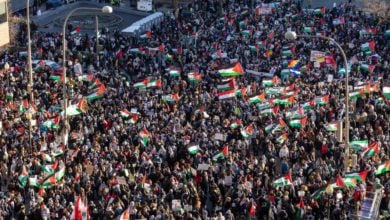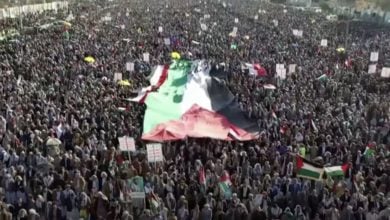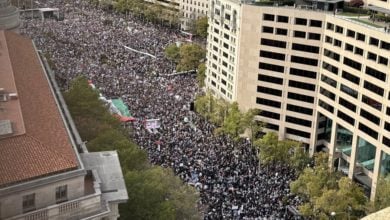Photo: Supporter of the campaign for justice for Sebastián Moro at an event in June, 2022. Credit: Paula Penacca
The article below was written amid the 2019 coup in Bolivia by journalist Sebastián Moro. Less than two weeks later, Moro was murdered by forces involved in the coup. The struggle to bring his killers to justice continues today. As the leaders of the coup regime face accountability for their crimes, Liberation News is reprinting this article to raise awareness of this crucial case.
Sebastián worked for Radio Nacional in Mendoza, Argentina, for almost a decade. He also wrote about human rights from a committed perspective for different media and covered the trials for crimes against humanity committed under the former dictatorship of Argentina for the Juicios Mendoza journalistic group. Sebastian was one of the thousands of journalists who for economic or political reasons lost their jobs in Argentina and/or suffered censorship and persecution with the arrival of the right-wing government headed by Mauricio Macri in 2015.
Attracted by the process of change led by Evo Morales and Álvaro García Linera, in February 2018, he decided to continue living in Bolivia. He settled in La Paz where he worked in the media of the Trade Union Confederation of Peasant Workers as chief editor of the newspaper Prensa Rural and host of a program on Radio Comunidad.
Sebastian also worked as a correspondent for the newspaper Página 12, having written dozens of articles on the process that came after the October 20, 2019, elections which led to the coup. In those days he was interviewed by the Argentinian media and by several South American media companies and his was a first warning voice about the unfolding anti-democratic sedition.
Read more information about the killing of Sebastián Moro here.
Follow updates from the campaign for justice here.
Crisis in Bolivia: Women marched against racism
Written by Sebastián Moro, November 7th, 2019
Originally published in Pagina 12
Translation by Sebastian Link
Since October 20, attacks by [Bolivian president Evo] Morales’ opponents against women wearing polleras and with indigenous features have been recorded in cities such as La Paz, Santa Cruz, and Cochabamba. During the past week, the Alliance of Women’s Social Organizations for the Democratic and Cultural Revolution, made up of women from multiple organizations of workers, peasants, indigenous, Quechua, Guarani, public servants, students, and long-standing social fighters, among others, repudiated the acts of discrimination and violence.
The trade unionist Paola Aguilar Serrudo suffered one of the most brutal episodes of intolerance experienced by the civic leaders of Santa Cruz. She denounced kidnapping, torture, and serious injuries before the National Committee to Fight Racism and all forms of Discrimination. Complaints of this type motivate the mobilization of women and are complemented by the demand to end the [right wing, pro-coup] civic strike, since they and their families are the most harmed by the weakening of the informal economy.
The letter of violence
Finally, as expected, last night, the latent violence broke out in La Paz. Skirmishes and clashes have not been lacking during the more than two weeks of protests against the results of the October 20 elections. However, now, the rumor circulating since the end of last week has been confirmed: groups of university students from the Universidad Mayor de San Andrés (UMSA) — the largest in the country — who responded to the outgoing university President Waldo Albarracín, would converge with members of the [fascist organization] Unión Juvenil Cruceñista (UJC) to escalate tactics and logistics in the clashes in the streets of La Paz, especially in the area of Plaza Murillo, which concentrates the ministries, Legislative Assembly and Government Palace — Casa Grande del Pueblo — guarded by hundreds of members of social organizations and the Movement Towards Socialism (Movimiento Al Socialismo, MAS).
There were clashes of all kinds: between those who demand the resignation of President Morales and those who defend him and, around midnight, between students and police. There was fire, stones, blows, and detonations of dynamite. The Police used a riot control car and chemical agents. The balance was at least eight injured – six university students, a community member from Oruro, and a doctor, the latter with brain injuries – and several detainees.
José Antonio Barrenechea, Departmental Commander of the La Paz Police, reported that the arrests were “for violent attacks and possession of explosives and blunt objects.” “We met people opposed to pacification who attacked our personnel with stones, explosives, and blunt objects,” he explained to the state [news] agency ABI. After three hours of operations, the Police regained control over the area, but the university students reunited to block the surroundings of the UMSA, a blockade that continues to this day, along with others in key downtown areas.
Albarracín, who incited civil war during the first days of the upheaval, warned hours before on the university channel, that he would violently remove the ‘Ponchos Rojos’ – peasant farmers from La Paz supporting Evo Morales – if they entered the vicinity of UMSA. “As soon as they step inside the university, we’re going to kick them out. So don’t even dare,” he threatened. In turn, police reports revealed that the university President authorized the use of spaces of the public institution for young people to hide shields, masks, explosives, and other elements for attacking.
It is also not ruled out that another trigger for the violence was the much-talked about letter of resignation written by the [coup leader] from Santa Cruz, Luis Fernando Camacho. In the afternoon, the letter began to circulate as replicas in different conflict nodes. For example, the students held it as a trophy and the peasants burned it as a sign of repudiation.
The letter even reached London, where Bolivian residents rebuked Luis Almagro, head of the Organization of American States – the body in charge of auditing the ballot that determined the victory of the MAS in the first round – and gave him the extortionate mandate that Camacho could not take back to Santa Cruz with a signature before a people that was going to wait for him on their knees, as he promised in the town hall on Monday.
True to his style, Almagro tweeted, “the protests over the audit mission make me reaffirm the conviction that it must continue its work. The people of Bolivia deserve all the technical, legal, and political certainty, what is more necessary than ever.”
War on the economy
At this time, the country is semi-blocked off due to the change in strategy, which has moved from urban barricades to taking over institutions. Pickets remain on some interdepartmental routes in addition to the decision of the heavy cargo transport sector to block international passages. With this situation in place, the Bolivian economy already feels the blow of more than two weeks of the civic strike.
The Minister of Economy, Luis Arce, reported that the economic damage reached 167 million dollars nationwide — at a daily rate of 12 million — and pointed out that the negative effect on the Gross Domestic Product will increase after the announcement of public institution take-overs and the closure of borders, as is the case with the National Tax Service or National Customs, whose income is paralyzed.
“The measures that the Civic Committee has taken will have consequences for the municipalities, regional governments, and public universities that receive resources from the co-participation,” warned Arce, indicating that one of the most affected sectors is the industrial sector, “which, little by little, is running out of supplies to operate.”
Another unwanted effect of the blockades, and one that harms tens of thousands of beneficiaries, is the provisional suspension of payments of the Dignity Rent [social program] for older adults – “perhaps the only periodic support that our grandparents receive” – and the Juancito Pinto Bonus for schoolchildren, given that the seizure of institutions on the orders of Fernando Camacho this Monday, also contemplates banking entities, affecting their security and that of the population. “That is paid in offices of the Union Bank, which have been taken over, and of the Senasir – National Service of the Distribution System – several of whose agencies have also been taken over by the civic committee. We are stopping the payment of pensions,” the minister communicated.
Industrialization on hold
In addition to the disturbances caused to a population and economy increasingly captive to the extortionary measures of the opposition, another strong blow to the country’s development occurred – and it has to do with the industrialization of lithium, or rather with its interruption.
After pressures that began in the weeks prior to the elections, the [right-wing] Potosi Civic Committee managed to get the government to repeal the decree that enabled the creation of the YLB-ACISA joint venture. The YLB-ACISA included [state lithium company] Yacimientos de Litio Bolivianos and the German company ACI Systems Gmbh, which had already guaranteed 1.3 billion in investments in industrial plants in the Uyuni salt flat to reach a production volume of up to 65,000 tons per year, with which Bolivia would reach the Chilean mega-companies and transnational corporations’ levels.
The project contemplated the production of lithium hydroxide and lithium-ion batteries on an industrial scale to export to different markets, mainly Germany. According to the digital portal Primera Línea, COMCIPO is advised by Juan Carlos Zuleta, a Chilean government official. Today, in statements to the media, the leader of COMCIPO, Marco Pumari, called society to “put pressure on the Government House” and asked that the protests move from the regional departments to La Paz.





